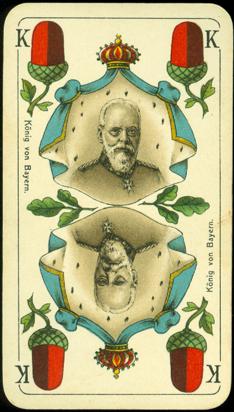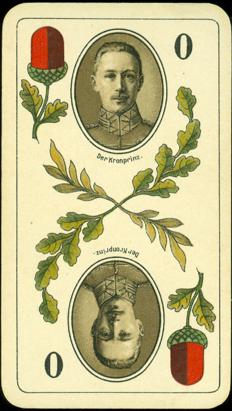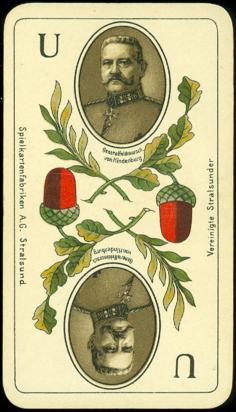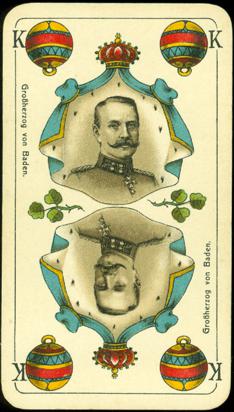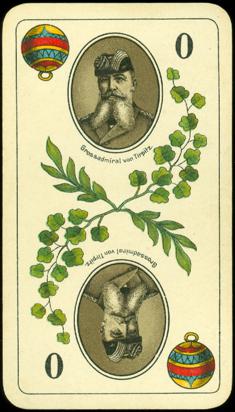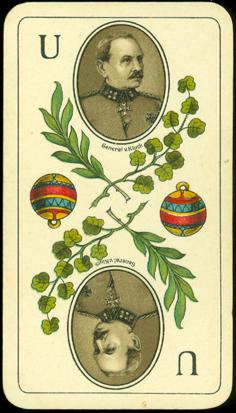August 2014
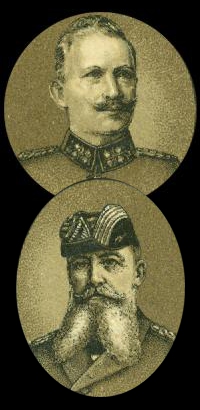 |
It wasn't a good month to visit the outdoor
markets. Except for the first week August turned out to be a very wet
month. So we only visited 2 open air antique markets. One had already
brought us some nice old finds in July, but this time we only bought a
beautiful Wedgewood porcelain holder with a (standard) deck
inside.
So our new decks had to come from the internet again. Ebay, the Dutch
auction site, both showed some very interesting decks and we didn't hold
back in bidding, but we were outbid on several auctions. Once by 21
cents, but we had a good laugh about that, as the deck went to a fellow
collector that we have a high regard for. So what did we choose this
month? |
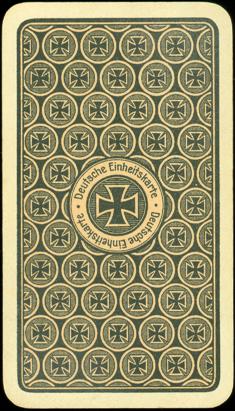
|
|
It wasn't just the fine printing of the
portraits, that tipped the scale. This year we also commemorate the
beginning of the Great War and all the millions of lives that this war has
cost. Because this German deck was published for that war, this made it
just a little bit more interesting to show here than a partial (38/52)
English transformation deck from 1862. That was a close second, but we had
some more decks on our shortlist too. We had to wait long, but at last we
received the Steampunk Goggles deck by Mike Lees. We also received the
latest "Clipped Wings" deck by Emmanuel José. We had backed
both decks at Kickstarter. And let's not forget to mention that nice
Latvian deck that we won on Ebay. |
A few things
were easy to find. The title of the deck is on the backs: "Deutsche
Einheitskarte" (German Unity cards) and the name of the manufacturer is on
the Unter of Acorns: the Vereinigte Stralsunder Spielkartenfabriken A.G. from
Stralsund. It's probably not
a very often seen deck, as we had to search hard to find some information about
it. We were surprised that we couldn't find it in all the Cartorama catalogues
that we have here. And it wasn't mentioned in the 1st volume of the Franz Braun
catalogues either, which is about German decks from WW I. But we did find a
reference in Han Janssen's book ("Geschiedenis van de Speelkaart", p. 228) and a second one in Uwe Volker
Segeth's
"Spielkarten" book in the Battenberg Sammler-Kataloge series (deck nr. 107,
p. 133). Han Janssen dates the deck as c1915 and Uwe Volker Segeth as 1914/1915.
We tend to think that the deck was published in 1914, maybe even before the war
had begun. On the 10 of Acorns the
portrait of Von Falkenhayn is shown as Minister of War (Kriegsminister). He was
appointed as such in July 1913. However, on 14 September 1914 he was appointed as
Chief of Staff, replacing General Motke after the 1st Battle of the Marne. If
the deck would have been produced in 1915, there would have been ample time to
use the correct "Chef des Generalstabs" in the caption underneath the
portrait. Also a number of battleships, depicted on the 8's and 7's, had already
been sunk by the end of 1914.
Han Janssen mentions Herrmann Petzoldt as the designer of this deck, but he
doesn't mention the number of cards. Uwe Volker Segeth mentions that his
deck has 32 cards. Our deck has 36 cards, but it didn't come in an original box
or wrapper. Han Janssen also mentions that there was an accompanying leaflet, in
which this deck was presented as New Unity card, meant to ban all foreign (read:
French) influences from playing cards. Well.... it has German suits and ranks.
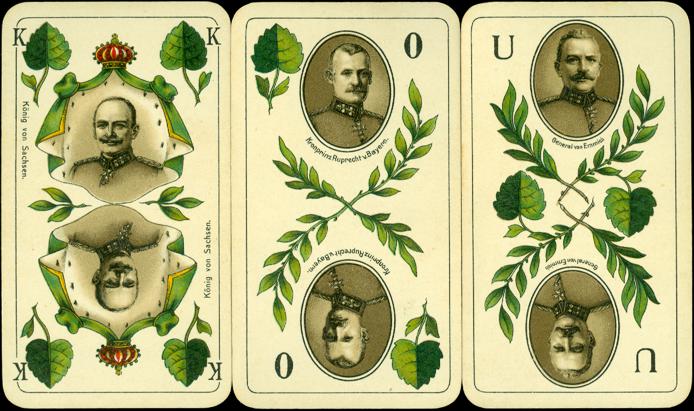
The deck shows
royalty, noblemen and high ranking soldiers. The Kings depict actual kings,
except for the king of bells, which shows a Grand Duke. In the Leaves suit the King of Saxony
is depicted. He will be the last King to reign there. Friedrich August III lost his throne on
November 13, 1918, when the republican revolt had reached his door. The
unter shows general Von Emmich.
The King of Acorns
depicts the King of Bavaria, Ludwig III, who reigned from 1913 - 1918. However,
his son,
crown prince Ruprecht, is depicted as the "Ober" in the Leaves suit
(see above), which seems a bit inconsistent. In the Acorn suit the caption of
the Ober just says "The Crown Prince" without further clarification.
In those days probably immediately recognized, but we can't put a name to him.
The Unter shows the portrait of general field marshal Paul Von Hindenburg. He
had retired in 1911, but was recalled at the outbreak of the war. In 1916 he
succeeded Erich von Falkenhayn (see 10 of Acorns) and was appointed Chief of
Staff. After the war, in 1925, he was elected as the second President of the
Weimar Republic. He died in 1934, leaving a vacant position that was
immediately taken by the self appointed "Führer und Reichskanzler",
A. Hitler.
Kaiser Wilhelm
II is on the "daus" (ace) of each suit. He's the last German emperor
and his reign ended together with the Great War (WW I).
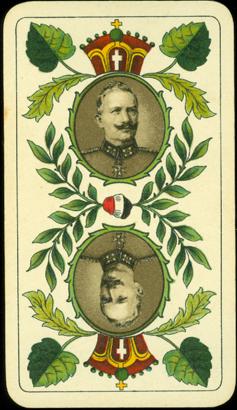
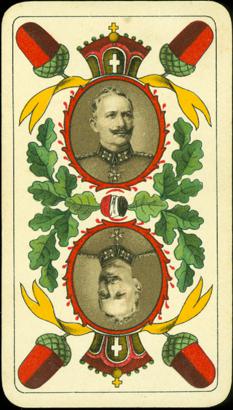
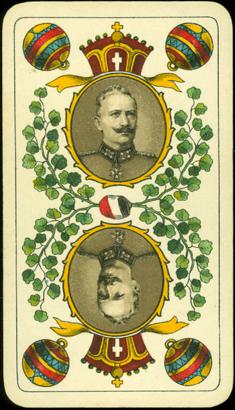
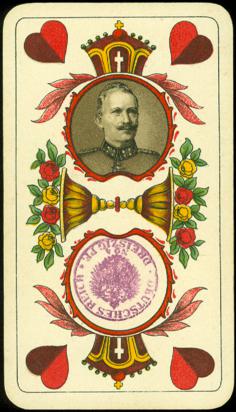
CLICK ANY ACE
TO SEE ALL THE PIPS OF EACH SUIT
In the Bells
suit the Grand Duke of Baden is accompanied by Grand Admiral Von Tirpitz and
general Von Kluck. Frederick II was the last Grand Duke of Baden, he reigned
from 1907 - 1918. From 1890 on Grand Admiral Alfred von Tirpitz had build up a
large fleet for Prussia. It wasn't big enough though to defeat the English
Royal Navy and in 1916 Von Tirpitz was dismissed and he never regained power.
He did turn to submarine warfare and the destruction of allied and neutral
ships triggered the US to proclaim war on Germany in 1917. General Alexander
von Kluck was also a Prussian. He was wounded by shrapnel in 1915 and retired
from duty in 1916.
King Wilhelm II of Wurttemberg was also the last king there. His reign lasted
from October 1891 to November 1918. On the Ober is the portrait of Albrecht,
Duke of Wurttemberg, an important military leader at the outbreak of the
Great War. He was general field marshal and commanded the German 4th Army from
1914 - 1917 and until 1918 the Army Group Albrecht. The Unter shows general
Hans von Beseler. Just like Von Hindenburg he was recalled from retirement and
was appointed commander of the 3rd Reserve Corps of the 1st Army under general
Alexander von Kluck (on Unter of Bells).
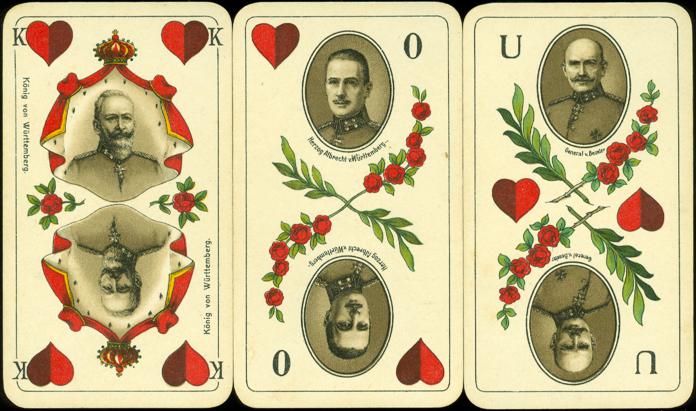
A few general
remarks can be made to end with.
First of all a word of praise for the quality of the designs and printing. While researching the depicted persons each time we were struck by
the likeness of these small portraits. They're done so fine that they're
almost photographic. The VSS did a good printing job on this deck, but had a
poor choice in type font for the indices. It even looks as if 3
different type fonts were used, while the use of indices is in fact superfluous.
The kings can be easily distinguished from the aces, not in the least because
the names of German Kings are mentioned there along the sides. As usual the
Ober and Unter can be distinguished by the place of the suit sign. Above, next
to the portrait for the Obers and somewhat in the middle, underneath the
portrait, for the Unters.
The deck was
probably published to raise support for the war, just before or right after
the Great War had started. The title Unity Cards may express the unity of the
depicted leaders, but maybe it can also be seen as a call upon the general
public to unite behind these men, who will lead (or have led) them into war.
The deck is not often seen, certainly not as often as similar German War
decks, like the "Deutsche Kriegskarte". The latter has known several
editions, totaling almost a million copies, and is relatively easy to find.
It's likely that of these Unity Cards only one edition was made, because the
deck emphasizes the German naval power. Of the 12 pips that don't depict a
person 10 show different ships. However, the German naval power in WW I wasn't
that strong at all. Besides a good number of these ships also a few of the
depicted commanders and an admiral hadn't survived the first year of the war.
Especially the Battle of the Falkland Islands had not only caused great losses
for the German Navy, but also for the depicted ships in this deck. It would have been improper to publish further editions with these images
after December 1914. A single, one-time edition could also explain the
relative rareness of this deck.
***************4/9/2014***************
We had asked
our German fellow collector Wilfried Kaschel to give his opinion about the
deck and this article, because he is working on a book/catalogue about the
Vereinigte Stralsunder Spielkarten-Fabriken A.G. that will be published next
year. He sent us two pages of this catalogue and proved us wrong.
|
The
first surprise he had, was that there has been a second edition, in
which the line around the design on the kings could be changed as the
indices were now placed in the middle on top, see the king of acorns
here. They have the same height now too as the indices on the Obers
and Unters. |
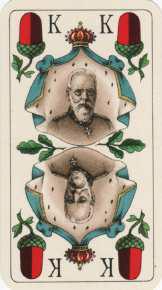 |
"By their images the German Unity Cards aim to keep the memory
alive of the present great era, in which the enemies have united to
destroy the German empire; at the same time it will evoke the feeling
of gratitude towards the German army and their leaders, who have
together with the Emperor deserved well in the frontline in defense
against the enemy's attack. In this sense the German Unity Cards
present a piece of history, of which the German people can be proud
until the end of time."
This part of the
accompanying leaflet obviously gives the explanation for this
publication. |
|
|
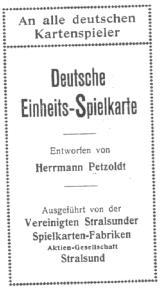 |
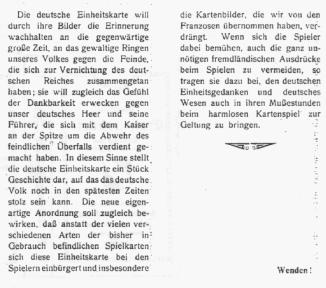
|
|
Here below
is a part of a letter that was send on August 12, 1915, by the VSS to
the Oswald Uhle Carton Factory in Oberfrohna about the Unity Cards:
"We have very recently published these cards for the first time
and it was so strongly in demand, that the first edition is completely
sold out and a new print is in progress." |
 |
So it's clear
that the first edition of this deck dates from 1915. It's a little vague but
"very recently" may well be a few months back, maybe in the
beginning of spring. I don't know how long it took in those days to prepare
the publication of a deck. There must be a good period between conceiving the
idea, designing the cards, preparing them for printing and the actual
printing and final publication.
However, I'm still a bit puzzled by some things. Is it possible that in the
concept stage Von Falkenhayn was still Minister of War and is it likely that
the Battle of the Falkland Islands came at an unfortunate moment in the
creative process, after (most of) the cards had been designed? Why else show
ships that have been sunk by the enemy and leaders who went down with them,
alongside living leaders and more fortunate ships? In the accompanying leaflet
there 's a long introduction about how to judge these cards (see above), before coming to
the actual message "An all deutschen Kartenspieler" (to all German
card players) to avoid playing with patterns that were copied from the French
and not use foreign expressions while playing.
In 1915 the frontline of the war had come to a halt in the northern part of
France. There were no great victories to celebrate, but instead some severe
losses by the Navy in different battles at sea. So, although being the
aggressor and instigator of the war, the German Empire is presented in the
leaflet as a victim in the Great War and the German army as great defender
against attacks on the motherland.
I still think that the
deck was conceived as a propaganda deck for going to war, but believe that it was cheaper to revalidate the
deck in a leaflet by turning it into a commemorative deck. This would pave the
way for a second print run too.
BACK TO PRESENT MONTH



